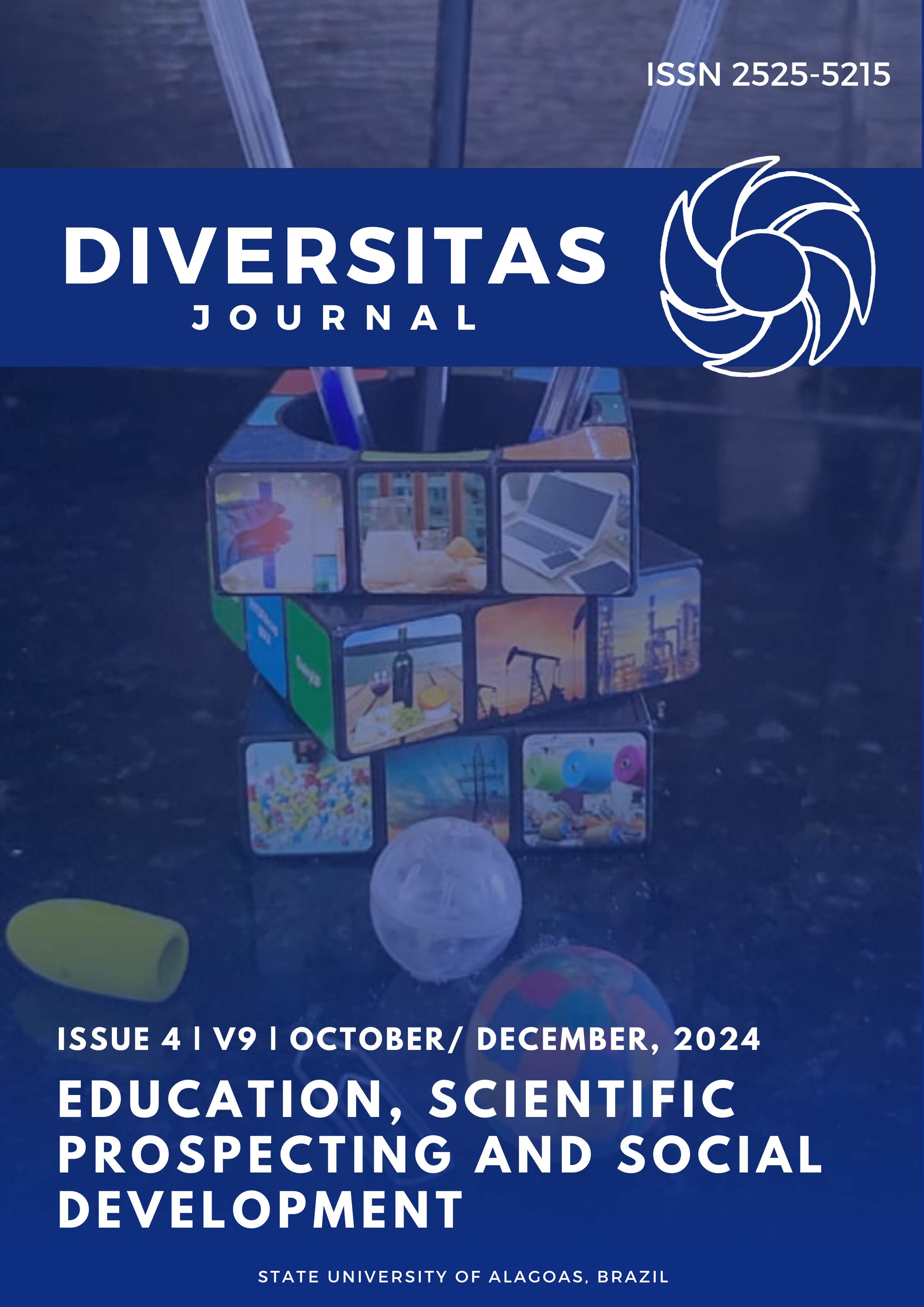Epidemiological profile of pregnant women infected with the human immunodeficiency virus in São Luís, Brazil, from 2019 to 2022
DOI:
https://doi.org/10.48017/dj.v9i4.3031Keywords:
HIV seropositivity, Epidemiology, Prenatal careAbstract
The Human Immunodeficiency Virus is a pathogen that causes one of the most well-known sexually transmitted infections in the world. It mainly affects immune cells and is transmitted through contact with fluids from infected people. HIV infection in pregnant women is an alarming problem, given its capacity for vertical transmission. The aim was to describe the epidemiological profile of HIV-infected pregnant women in the municipality of São Luís - MA, from 2019 to 2022. This is a retrospective, descriptive, quantitative study. The data was obtained from compulsory notification forms from SINAN, with information on HIV-positive pregnant women notified from 2019 to 2022. There was a greater predominance of cases between 25 and 35 years old (47.0%), self-declared brown (76.0%), with complete high school or incomplete higher education (39.2%). With regard to the gestation period, 48.6% were in the third trimester; 56.3% were tested before prenatal care and 37.4% during prenatal care and 89.2% attended follow-up appointments. Around 22.2% had an elective cesarean section, with 37.6% live births. Schooling, laboratory evidence of HIV and pregnancy progression showed significant differences. Adequate prenatal care therefore acts to provide early management, diagnosing and treating infected pregnant women, minimizing harm to maternal and fetal health.
Metrics
References
Bezerra, E. O., et al. (2012). Análise da vulnerabilidade sexual de estudantes universitários ao HIV/Aids. Revista da Rede de Enfermagem do Nordeste, 13(5), 1121-1131.
Brasil. Ministério da Saúde. (2022). Aids/HIV: o que é, causas, sintomas, diagnóstico, tratamento e prevenção. Disponível em: https://www.gov.br/saude/pt-br/assuntos/saude-de-a-a-z/a/aids. Acessado em: 05/09/2022.
Brasil. Ministério da Saúde. (2021). Boletim Epidemiológico Especial - HIV/Aids 2021. Disponível em: https://www.gov.br/saude/pt-br/centrais-deconteudo/publicacoes/boletins/epidemiologicos/especiais/2021/boletim-epidemiologico-especial-hivaids-2021.pdf/view. Acessado em: 17/09/2022.
Brasil. Ministério da Saúde. Departamento de DST, AIDS, e Hepatites Virais. (2015). Protocolo Clínico e Diretrizes Terapêuticas para a Prevenção da Transmissão Vertical de HIV, Sífilis e Hepatites Virais. Brasília: Ministério da Saúde. Disponível em: http://www.aids.gov.br/sites/default/files/anexos/publicacao/2015/58572/pcdt_transm_vertical_091215_pdf_12930.pdf. Acessado em: 17/09/2022.
Brasil. Ministério da Saúde. (2022). Manual de gestação de alto risco. Secretaria de Atenção Primária à Saúde. Departamento de Ações Programáticas – Brasília: Ministério da Saúde.
Brasil. Ministério da Saúde. (2021). Nota informativa nº 2/2021-DCCI/SVS/MS. Disponível em: http://azt.aids.gov.br/informes/Informe%2003_21%20-%20NI0221%20%20Recomenda%C3%A7%C3%B5es_uso_RAL%20100mg%20granulado.pdf. Acessado em: 15/09/2023.
Brasil. Ministério da Saúde. (2014). Protocolo clínico e diretrizes terapêuticas para manejo da infecção pelo HIV em adultos. Secretaria de Vigilância em Saúde. Departamento de DST, Aids e Hepatites Virais.
De Jesus, M. L., et al. (2016). Relato de experiência no PET Saúde: reflexões sobre práticas sexuais protegidas e nível de escolaridade. REVASF, 6(10), 125-146.
De Lima, S. S., et al. (2017). HIV na gestação: pré-natal, parto e puerpério. Ciência & Saúde, 10(1), 56-61.
Mello, Caren Julianne Filgueiras de Assis, et al. (2020). Terapia Antirretroviral: principais causas de abandono no estado do Amapá. Revista Eletrônica Acervo Saúde, 12(8), e3423-e3423.
Lima, C. N., De Moraes, L. P., & Rêgo, H. C. L. J. (2019). Aleitamento materno: a visão de puérperas soropositivas para HIV e HTLV quanto a não amamentação. Nursing (São Paulo), 22(248), 2583-2586.
Mario, Débora Nunes, et al. (2019). Qualidade do pré-natal no Brasil: Pesquisa Nacional de Saúde 2013. Ciência & Saúde Coletiva, 24, 1223-1232.
OPAS. (2021). Diagnóstico, sintomas, causas, prevenção e tratamento da AIDS. Disponível em: https://www.paho.org/pt/topicos/hivaids. Acessado em: 02/09/2022.
Perotta, M., et al. (2023). Perfil sociodemográfico e aspectos gestacionais de mulheres com HIV/Aids de Curitiba, Brasil. Revista Gaúcha de Enfermagem, 44, e20220202.
Rahim, S. H., et al. (2017). Gestantes e puérperas soropositivas para o HIV e suas interfaces de cuidado. Rev. enferm. UFPE on line, 11(suppl. 10), 4056-4064.
Soares, J. P., et al. (2017). Prevalência e fatores de risco para o hiv/aids em populações vulneráveis: uma revisão integrativa de literatura. Arquivos Catarinenses de Medicina, 46(4), 182-194.
Teixeira, S. P., et al. (2020). Perfil epidemiológico de gestantes com HIV admitidas em uma maternidade de referência no Amapá. Revista Eletrônica Acervo Saúde, 12(2), e2543-e2543.
Trindade, L. N. M., et al. (2021). Infecção por HIV em gestantes e os desafios para o cuidado pré-natal. Revista Brasileira de Enfermagem, 74(suppl. 4), e20190784.
Mocelin, Helaine Jacinta Salvador, et al. (2023). Barreiras e facilitadores do enfrentamento de HIV/aids e sífilis por venezuelanas residentes no Brasil. Revista Panamericana de Salud Pública, 47, e3.
Downloads
Published
How to Cite
Issue
Section
License
Copyright (c) 2024 Raynara Rodrigues Pires, Katiane Shirley Machado Araújo Araújo, Jéssica Gomes Silva, Renata Rocha Ferro, Bruno Costa Sousa Sousa , Gabriel Pereira de Sousa, Assiria de Araújo Chaves Correia, Phelipe Austríaco Teixeira, Denise Alves Santos, Neemias Costa Duarte Neto, Francisca Bruna Arruda Aragão

This work is licensed under a Creative Commons Attribution 4.0 International License.
The Diversitas Journal expresses that the articles are the sole responsibility of the Authors, who are familiar with Brazilian and international legislation.
Articles are peer-reviewed and care should be taken to warn of the possible incidence of plagiarism. However, plagiarism is an indisputable action by the authors.
The violation of copyright is a crime, provided for in article 184 of the Brazilian Penal Code: “Art. 184 Violating copyright and related rights: Penalty - detention, from 3 (three) months to 1 (one) year, or fine. § 1 If the violation consists of total or partial reproduction, for the purpose of direct or indirect profit, by any means or process, of intellectual work, interpretation, performance or phonogram, without the express authorization of the author, the performer, the producer , as the case may be, or whoever represents them: Penalty - imprisonment, from 2 (two) to 4 (four) years, and a fine. ”


















